Nothing beats a good strategy game. The process of discovering the perfect game plan, the anticipation as you assemble the cards to set it in motion, the nervousness that comes from waiting to see if your opponents have foiled you, and the thrill of finding out immerse you in the gameplay, invest you in its outcome, and make for truly satisfying gameplay.
Bunny Kingdom and 7 Wonders exemplify all of these traits through the mechanic of drafting cards. Both offer you a wide selection of draft archetypes to choose from and require you to make careful card selections based on imperfect information, often making the “right” decision difficult to determine in the moment.
If you could only bring one of these superb card drafting board games to the gaming table, however, which should you choose?
Bunny Kingdom plays ideally with 3-5 players, and it adds an extra layer of strategic depth to its 4 rounds of card drafting by having players use drafted cards to claim territories on 1-2 shared boards. A game is usually completed within 60-90 minutes. 7 Wonders allows 3-7 players to play, limits the interaction with its player boards, and finishes its 3 rounds of play in 30-45 minutes.
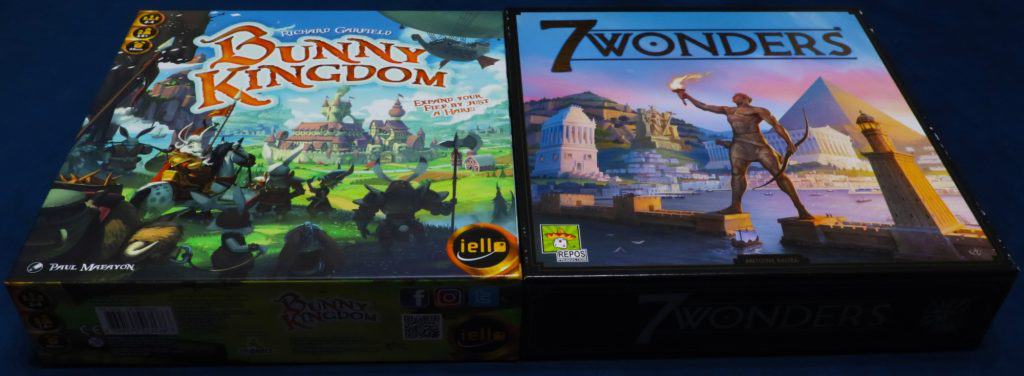
For those who are stuck trying to make the difficult decision between Bunny Kingdom and 7 Wonders, this comparison is exactly what you’ll need to buy the right game. Within, this article will cover the important differences between the two games, their pros and cons, and break down how each plays so you can determine which will be the better fit for your family and friends.
Bunny Kingdom and 7 Wonders Facts
Bunny Kingdom and 7 Wonders are both examples of introductory card drafting games. Players select a set number of cards from a hand, reveal their choices to the rest of the table once everyone has picked, then pass their remaining cards to the player on their left or right before repeating the process.
Players in Bunny Kingdom will use their cards to build fiefs, collect secret parchments for bonuses at the end of a game, and even become trade moguls to create the most prosperous kingdom. In 7 Wonders, you’ll construct buildings to become a master of military conflict, science, commerce, and civilian architecture as you strive to make your Wonder the finest in the world.
Bunny Kingdom Quick Facts
- Year created: 2017
- Number of players: 2-4 (2-5 with the Bunny Kingdom: In the Sky expansion)
- Playing time: 60-90 minutes
- Recommended player age: 14+
- Recommended number of players: 3+
If you would like to review a full strategy guide for Bunny Kingdom, you can find one here.
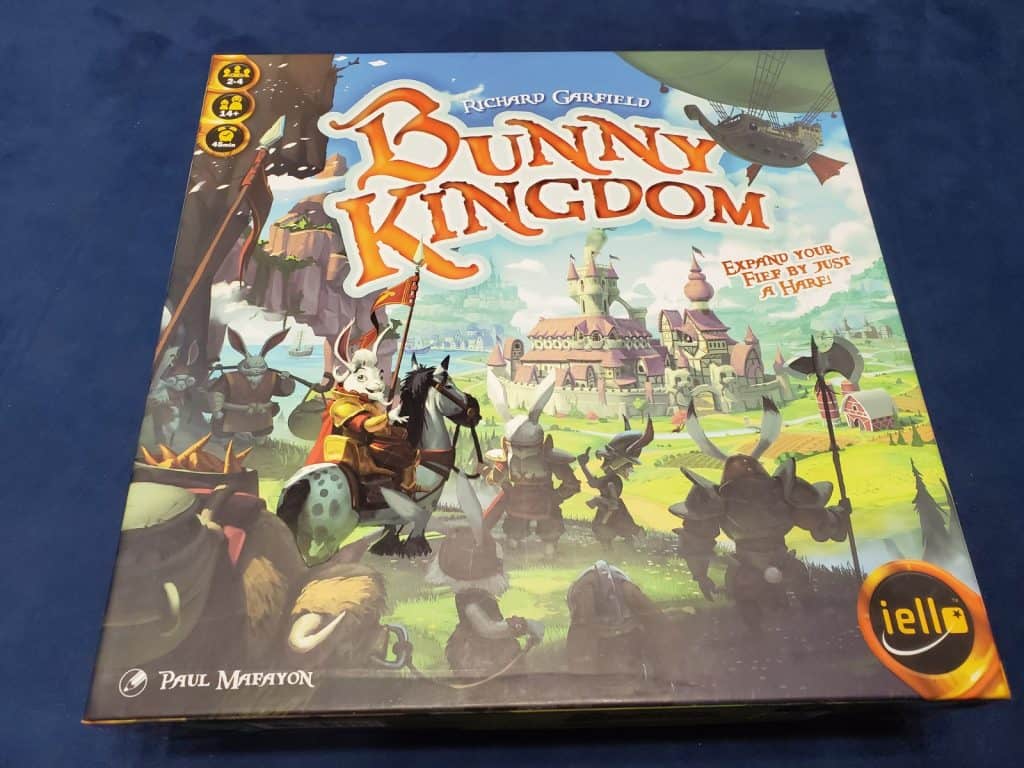
7 Wonders Quick Facts
- Year created: 2010 (2nd edition released in 2020)
- Number of players: 3-7 (2-7 in 1st Edition)
- Playing time: 30-45 minutes
- Recommended player age: 10+
- Recommended number of players: 3+
If you would like to review a full strategy guide for 7 Wonders, you can find one here.
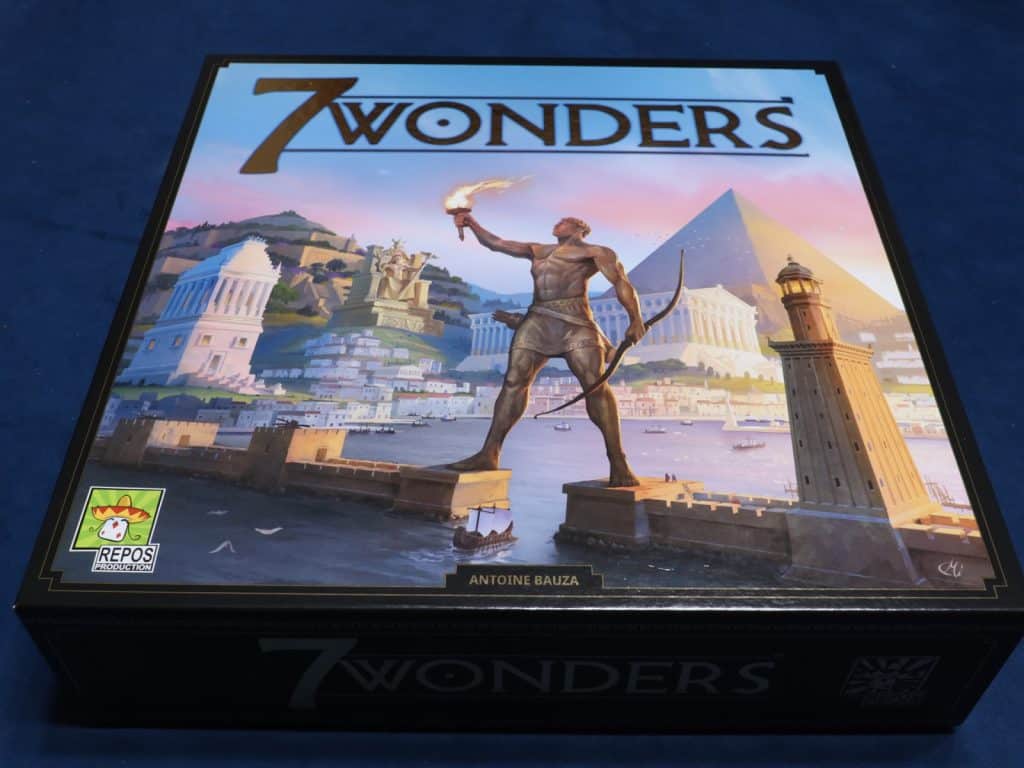
Differences Between Bunny Kingdom and 7 Wonders
While card drafting is the core mechanic throughout both of these board games, each executes this process very differently. To fully understand what makes each game tick, let’s break down their game mechanic differences in more detail.
Board Game Setup
The setup for 7 Wonders and Bunny Kingdom is going to showcase the first and second differences between both games, and they represent the biggest differences between each other.
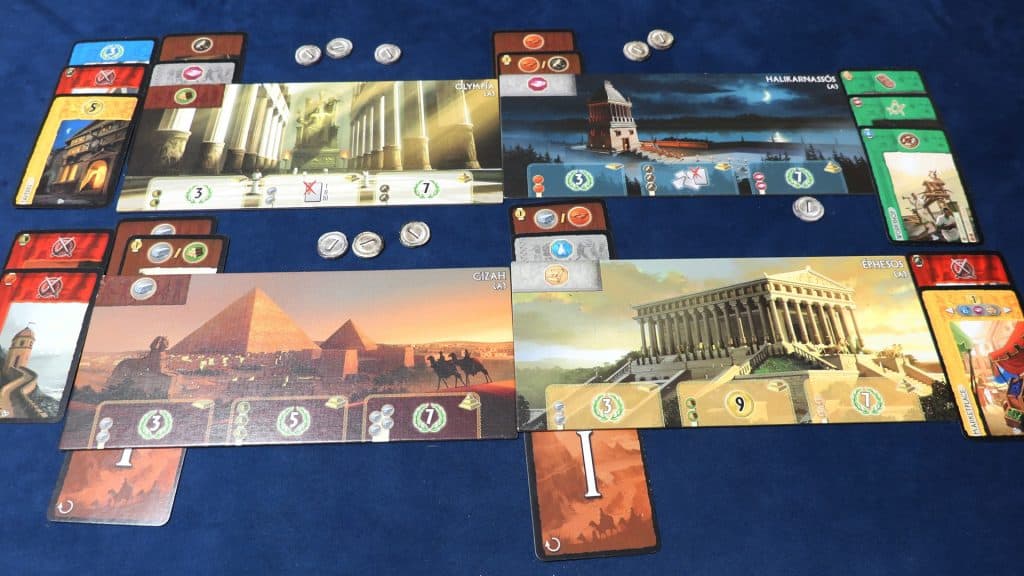
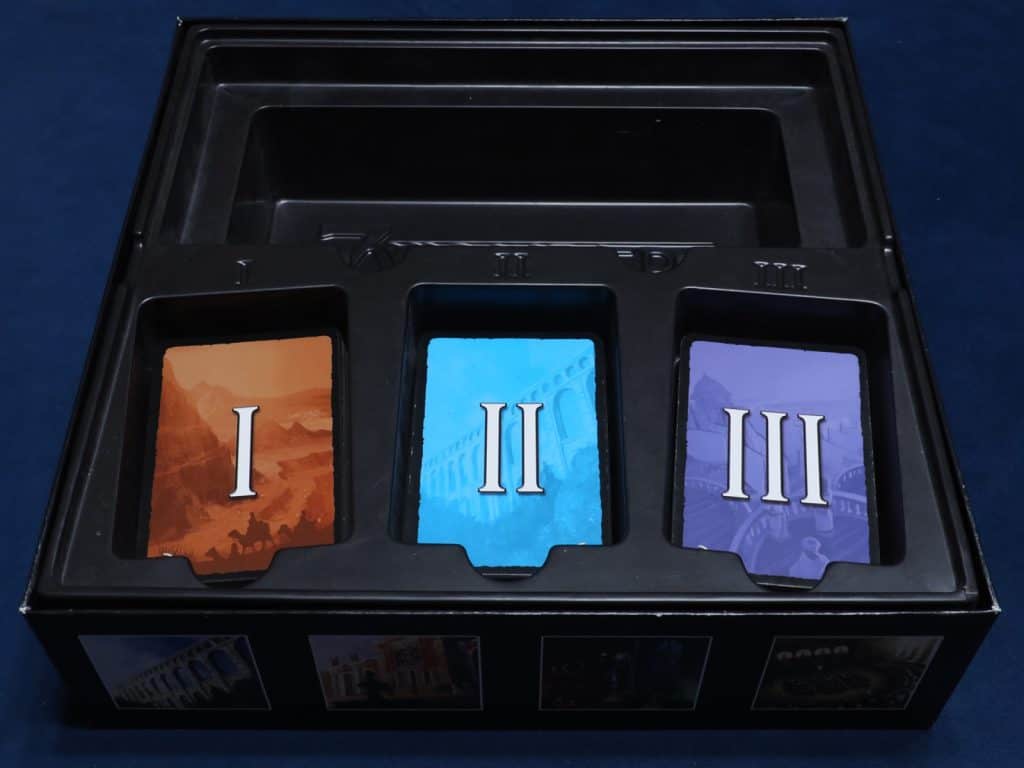
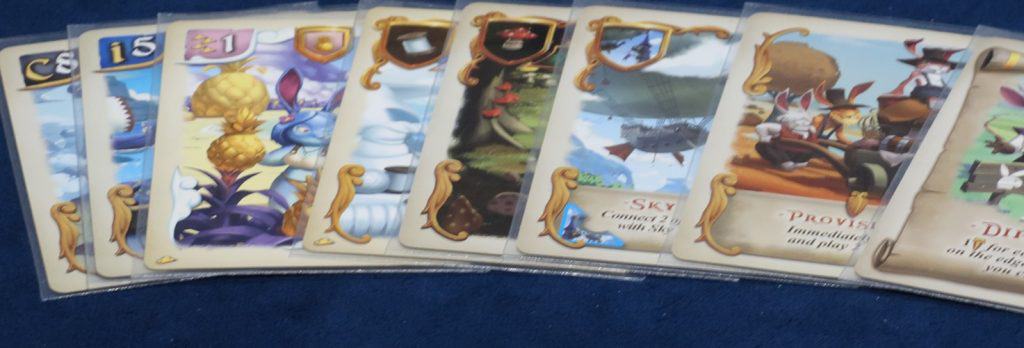
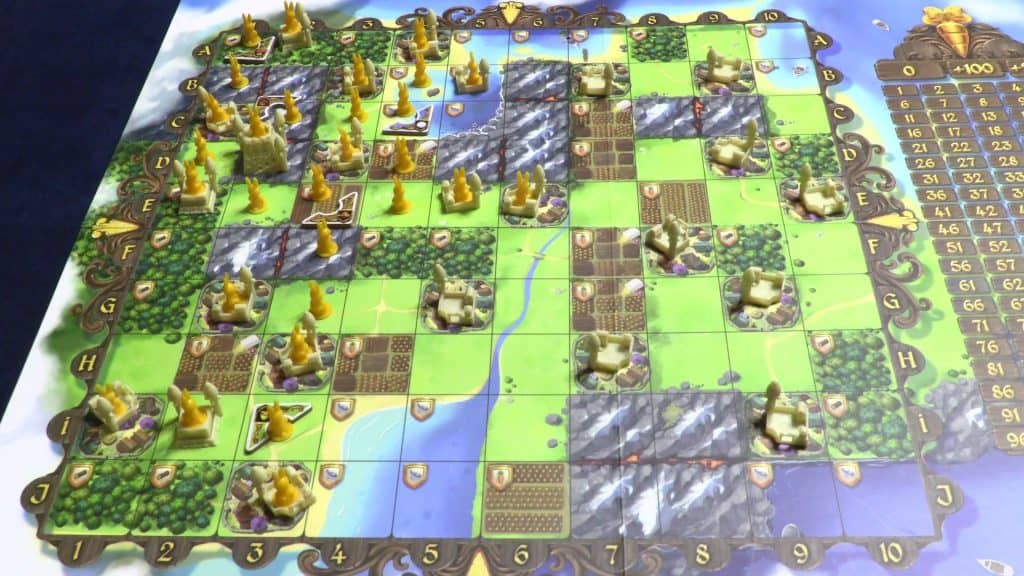
As you can see, the setup and structure for 7 Wonders is fairly consistent. The same core group of cards will always be available, with additional ones being added depending on the number of players in the game. Guild cards found in the 3rd Age deck are the exception, with a number of the 10 equal to the number of players +2 being randomly selected each game.
Bunny Kingdom adds a couple additional layers of complexity to this equation. First, its entire pool of cards is shuffled at the start for the game, and is dealt from for all four rounds of gameplay. This adds much more variance to games, meaning your experiences from several games could be quite different from one another.
You probably also noticed that Bunny Kingdom also utilizes a shared board rather than individual player boards, which introduces competition for territory to collect resources and build fiefs. There is a card for every square of territory you play with, adding opportunities for direct player interaction and interference that you won’t find in 7 Wonders.
Player Interaction

7 Wonders is actually pretty light on player interaction, limiting it to three key areas: commerce, military conflict, and card drafting. The commerce portion is very straightforward – if you don’t have all the resources to build a card, but a player on your immediate left or right does, you simply pay them 2 coins and then you can use 1 of their resources.
This is especially important to remember in the 3rd Age, where resources are completely unavailable to draft, so plan accordingly!
Military conflict is similarly straightforward. At the end of each Age, you and your neighbors on the immediate left and right will compare military shields. Whoever has the most receives a positive point marker whose value is determined by the Age you’re in. The loser receives a -1 point marker, and ties receive nothing.
Card drafting is considerably trickier, because you are constantly weighing which cards are most helpful to you against which cards you’re passing your neighbor. This can be especially important in games with fewer players, as it is more likely you’ll see the same hands multiple times, but this will still be a constant metric of measurement in 7 player games too.
Bunny Kingdom’s shared board and territory-based strategies ramp this interaction up considerably. You not only have to consider all the same things you would when drafting cards in 7 Wonders, but then also have to consider how that impacts the fiefs that are under construction or looking to expand.
This extra layer of complexity really ramps up the strategic potential of Bunny Kingdom, and as our board game group has repeatedly demonstrated, 45 minutes is a very optimistic playtime for this game, despite what the box says, because of the amount of time needed to consider all the different ways a hand of cards will change the game.
Resource Management
Resources are very important elements in 7 Wonders and Bunny Kingdom, but for very different reasons. In 7 Wonders, resource cards are akin to mana in Magic: the Gathering – you need specific resources to build most other cards, and each resource you generate refreshes while you’re picking your next card.

On their own, resources will not score you any points in 7 Wonders, but there are cards that will reward you for having them. Collecting enough during the 1st and 2nd Ages of the game is also crucial, as you will find none in the 3rd and final Age of the game. The best strategy is to take as close to what you need as possible, erring on the side of too many if you have to choose.
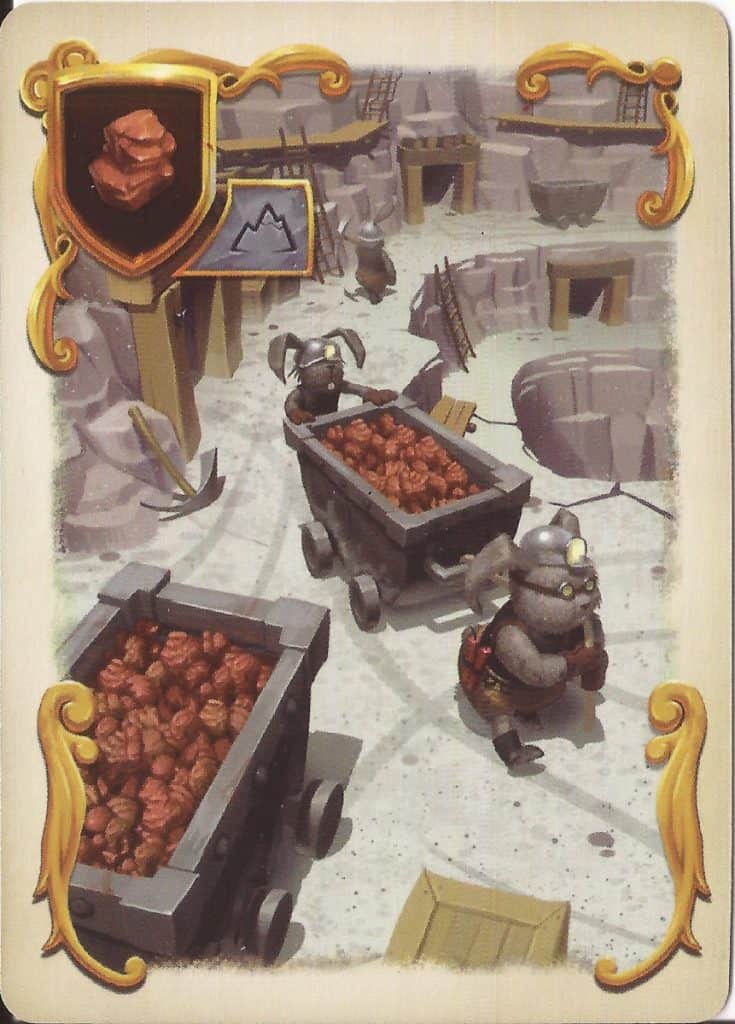
Bunny Kingdom, on the other hand, relies heavily upon resources for scoring. When scoring a fief, you’ll use this formula:
Strength (city towers) x Wealth (the number of unique resources in a fief)
In addition to the basic resources you’ll find on the shared board (carrots, fish, and wood), you can also accumulate additional Luxury Resources from cards, and Wondrous Resources if you’re playing with the expansion.
Luxury Resources are especially valuable when playing the Bunny Kingdom base game on its own, as building a big fief is consistently 1 of the 2 strongest strategies. Taking any that come across your path is usually the correct move, even if you’re only doing it to keep them out of the hands of others.
Parchment collecting, the 2nd of the Bunny Kingdom base game’s strong strategies, benefits from resources as well, as many cards will award you points for either reaching a certain number of resources or simply for any of a specific type you’ve collected, so even if you aren’t as invested in fief building, resources remain vital.
Scoring

We’ve touched on scoring a bit to this point, but the way it is handled between 7 Wonders and Bunny Kingdom differs quite a bit between games. In 7 Wonders, scoring is handled at the end of the game.
Military conflict is the sole exception to this, as you and your immediate neighbors will be comparing military strength at the end of each Age. Despite being checked each round, however, you’ll simply receive appropriate point markers, then use those to calculate the military component of your score at the end of the game.
Each type of card that can score points in 7 Wonders actually has its own section too, so whoever is tallying point totals can simply go around the table and ask each person for their points in a given category, which makes determining the winner a matter of some quick addition.
Bunny Kingdom, on the other hand, scores fiefs at the end of every single round, but waits until the end of the game to score Parchments and Trade Score (expansion only for the latter). Since you can hold elements like Luxury Resources between rounds, choosing the right time to build them into your fief can have a tremendous impact on your point total.
Expansions and Their Importance to Gameplay
7 Wonders, having been around for a while, has a pretty solid library of expansions. They include:
All of these serve as great ways to supplement existing game mechanics or switch up the core gameplay a bit if you and your playgroup are finding things to be a bit stale. That said, none are required to get a great experience – 7 Wonders is a perfectly complete game on its own merits, and has provided many hours of satisfying gaming for us.
If you’re looking for a good 2 player experience, Repos Production also offers 7 Wonders: Duel, which we’d recommend over trying to use the 2 player variant rules from the 1st edition run of the base 7 Wonders game.
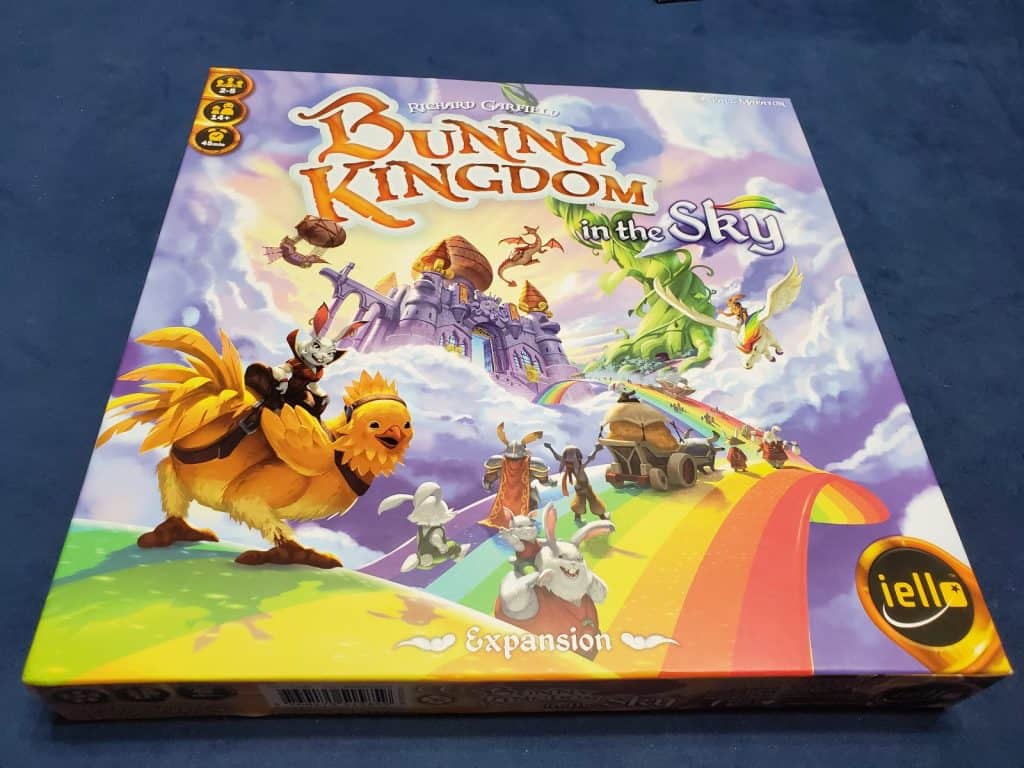
Bunny Kingdom only has 1 expansion, Bunny Kingdom: In the Sky, and while it certainly isn’t required for a high quality experience, it is strongly recommended.
Bunny Kingdom: In the Sky balances previously overpowered strategies from the base game and adds additional draft archetypes to the mix, enriching the gameplay possibilities and, in our opinion, fully completing the game.
The expansion also allows you to have up to 5 players in the game, which is a pretty significant plus when compared to the many board games that cap out at 4 players.
Bunny Kingdom Pros and Cons
Pros
- It’s easy to learn.
- The board and pieces are well-constructed.
- The box insert is well organized and offers enough room for the expansion.
- The board and components are colorful and the art has a lot of variety.
- Strategy options are surprisingly robust.
- The cards are standard size, making them easy to sleeve. Better still, sleeved cards fit in the box!
Cons
- The base game’s draft archetypes are a bit uneven in power level, meaning the expansion is required for proper balance.
- The expansion is also required if you consistently play with 5 players.
- If this is your board game group’s first card drafting game, it can be a little overwhelming at first.
7 Wonders Pros and Cons
Pros
- It’s easy to learn.
- The player boards and cards are durable.
- The box insert is well organized, and can hold extra cards.
- Gameplay is consistent without depriving you of strategic potential.
- The cards are big and easy to read.
- Accommodates large and small gaming groups by allowing 3-7 players to play.
Cons
- The base game box is not expansion friendly, with no additional room for extra player boards.
- The metallic shine on the box and card backs from 2nd edition is difficult to read in dim or indirect light.
- 1st and 2nd edition versions of this game have several differences between them, which can create confusion.
How to Choose Between Bunny Kingdom and 7 Wonders
Now that you’ve had a chance to look over the differences between Bunny Kingdom and 7 Wonders, as well as compare the pros and cons of each, how do you go about choosing between the two? Both hold esteemed places on our game shelves, but at $40+ a pop for the base games alone, that isn’t viable for all budgets.
If you have to make this incredibly difficult decision, here are some additional factors to consider.
Player Age
While both of these games are simple for adults to learn, neither is geared toward young children. That said, the more consistent nature and smaller card pool of 7 Wonders make it a better gateway card drafting game for those who are just getting into this style of gameplay.
The rules for 2nd edition are also incredibly well organized, and there are multiple inserts so new players can easily reference the information they need to answer common questions throughout the course of a game.
Bunny Kingdom’s complexity has the box recommending it for players who are 14 years of age or older (vs the 10+ for 7 Wonders), but families have often found that either game’s mechanics are within the grasp of those around 10 years of age.
That said, there are many more decisions to make in Bunny Kingdom, and being able to assess the possible consequences of your choices can create “analysis paralysis” for some. While this deeper level of strategy is often lauded as one of Bunny Kingdom’s greatest strengths, that sword does cut both ways, and can be a little much at times.
Playing Time and Board Size
If you’re looking for a game that you know will be finished within an hour, 7 Wonders is your pick here. The player boards and cards can sprawl out a bit, but if carefully organized, are also able to be set up easily on a play area as small as a coffee table. Games usually take 30-45 minutes.

For those that want to take up a whole dining room table, Bunny Kingdom has you covered. Newer print runs of the game use the larger version of its board, and everyone is going to have a lot of cards spread out in front of them as the game progresses.
We’ve found that most games take between 60-90 minutes to complete, but if this sees regular play at your house, it is definitely possible to finish in 45-60 minutes if everyone plays at a brisk pace.

Player Count
This is often the piece of criteria that finalizes a decision between these two games. If you want to play a game with 6 or 7 players, Bunny Kingdom simply isn’t capable of that. It isn’t even capable of 5 unless you have the expansion, which adds an additional cost to the equation.
If your playgroup is smaller, however, Bunny Kingdom’s gameplay is generally better than that of 7 Wonders at 3-4 players. 7 Wonders plays well at any player count it is designed for, but really needs at least 5 players to see the full extent of what each Age deck can bring to the table.
Higher player counts also reduce the number of times you’ll see the same hand during each Age, which adds to the level of variance between games. While this is also true of Bunny Kingdom, you take multiple cards at a time from larger hands than 7 Wonders, creating sufficient variance through fewer guarantees in those scenarios.
FAQs
What’s the Recommended Number of Players for Bunny Kingdom and 7 Wonders?
Both games play well with 3 or more players. Bunny Kingdom and 7 Wonders do have 2 player variants, but neither delivers a particularly satisfying card drafting experience. For the best possible experience, 7 Wonders typically excels in groups of 5 or more, and Bunny Kingdom plays well with 3-5 players.
How Quickly Can I Learn Bunny Kingdom and 7 Wonders?
Reading the rules for both games only takes a few minutes. A full grasp of the specifics for each game can usually be attained after 1 full playthrough.
Is There A Place I can Try Bunny Kingdom and 7 Wonders Online?
7 Wonders 2nd edition can be played on Board Game Arena, but there is not a dedicated online environment for Bunny Kingdom at this time. You might have some luck finding a demo copy at your friendly local game store though!
Are There Differences Between 7 Wonders 1st Edition and 2nd Edition?
Yes. The 1st edition and 2nd edition versions of 7 Wonders have quite a few differences, but the rules and flow of gameplay remain intact despite these adjustments between editions. Either version will provide you with an excellent gameplay experience.
Final Thoughts
Despite all the pros and cons, differences and similarities, and recommendations and cautions, there really is no clear winner between Bunny Kingdom and 7 Wonders. That said, you probably have a pretty good idea of which is right to pick up first for your family and/or gaming group now. We’d still recommend trying both if possible though – each brings a lot to the table, after all.
If you’re looking for a more straightforward, consistent card drafting experience, or for a fun, expandable game that accommodates large and small groups, 7 Wonders is the better pickup for you.
If you prefer deeper strategy with more options and higher variance between your games, Bunny Kingdom will be right up your alley.
Other Board Game Articles You May Love
- The Full Bunny Kingdom Strategy Guide
- The Full 7 Wonders Strategy Guide
- The Complete List of Differences Between 7 Wonders Editions
- Arkham Horror vs. Betrayal at House on the Hill
- Board Game Arena Premium Review
Braden is a founder of Assorted Meeples and has been a gamer & writer with a vivid imagination all his life. Don’t believe us? Check out his excitement when meeting Goosebumps author R.L. Stine as a kid! An avid Magic: The Gathering spellslinger for over 15 years, you can always convince him to shuffle up for a game (or three!) of Commander.

